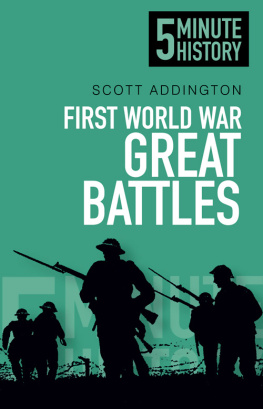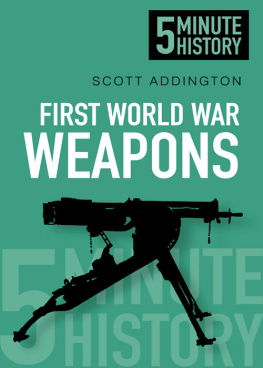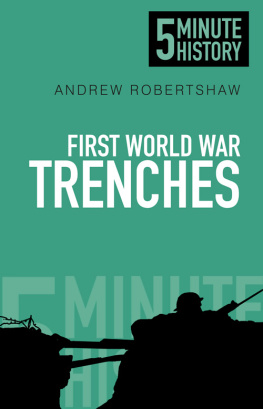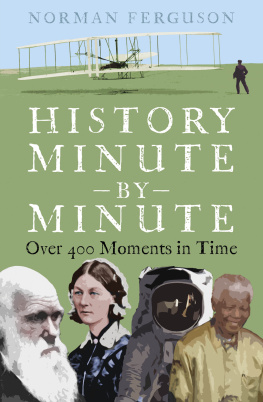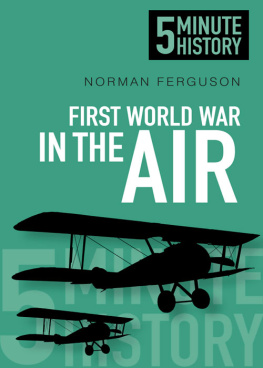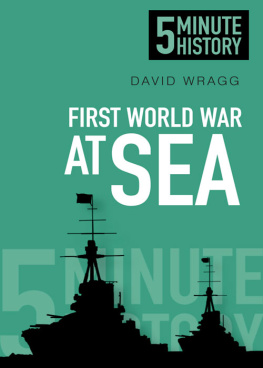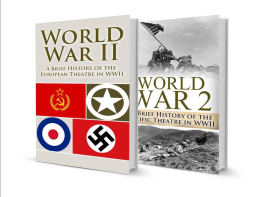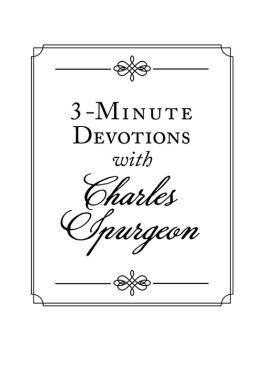
CONTENTS
THE FIRST WORLD War lasted for four years, four months and fourteen days, and accounted for over 35 million casualties, almost half of which died; indeed, 230 soldiers perished every hour of the conflict over those four-and-a-bit years. The attrition rate was, and still is, truly astounding.
For a soldier in the front-line trenches, there was a continual fight with the enemy, even if there was no official battle or big push raging. Trench raids, snipers, grenades and, of course, the shelling from enemy artillery caused front-line soldiers on both sides to be in almost constant danger. If this wasnt enough, on top of these daily terrors there were numerous large-scale offensives that have gone down in history as some of the most destructive and bloodiest battles ever waged.
As well as the huge loss of life, these battles are important due to their use of new technology. This was a time when the science of warfare was developing fast; poison gas, underground mines, grenades, mobile flame-throwers, tanks, advances in artillery tactics and the use of the air force for integrated air and ground offensives were all refined on the battlefields of the First World War. It was also when warfare reached beyond the professional soldier. Millions of ordinary men from all over Europe signed up to fight for their country. Even today the newspapers and online communities are full of newly discovered family heroes and their stories, and more often than not, this story involves one of the major battles such as Mons, Loos, the Somme or Passchendaele.
In trying to describe these battles for this 5 Minute History I have tried to be as succinct as possible without losing sight of the main points for the reader. I have also included a few interesting facts to add a bit of context, plus, with the inclusion of several eyewitness accounts, I have tried to inject a personal touch to these enormous battles. These are particularly fascinating and I have been moved when piecing them all together!
I hope you enjoy this brief overview of some of the most pivotal battles of the First World War and I hope it inspires you to read some of the brilliant in-depth accounts of these clashes that can be found both online and in physical bookshops.
SMA
Spring 2014
JUST A MATTER of weeks after declaring war on Germany, 80,000 members of the British Expeditionary Force (BEF) along with 30,000 horses and 315 guns of assorted size and calibre had landed in France and were marching straight towards the enemy who were passing through Belgium on their way to Paris.
It was on 22 August 1914 that the British got their first glimpse of a German soldier. During a routine reconnaissance patrol four enemy cavalrymen of the 2nd Cuirassiers were spotted by a forward patrol of the 4th Royal Irish Dragoon Guards, who immediately gave chase and opened fire. Captain Hornby of 1st Troop led his men in the pursuit and charged the Germans, killing several. He returned with his sword presented, revealing German blood.
DID YOU KNOW?
Four Victoria Crosses were won during the first day of fighting at Mons. They were awarded to Lieutenant M.J. Dease, Private S.F. Godley, Captain T. Wright and Corporal C.A. Jarvis.
Meanwhile, to the rear, the rest of the British Expeditionary Force decided to entrench roughly along a loose line at the Mons-Conde canal. They didnt really know how many Germans were on the other side of the waterway, but they would find out soon enough. Less than 80,000 British troops with 300-odd pieces of artillery were about to face off against 160,000 German soldiers who were backed up by double the amount of artillery.
I WAS THERE
Our first battle is a heavy, unheard of heavy, defeat, and against the English the English we had laughed at.
Walter Bloem, Reserve Captain, 12th Brandenburg Grenadier Regiment
DID YOU KNOW?
The British Expeditionary Force consisted of highly trained soldiers and during the battle they maintained such a high rate of fire with their rifles that the German attackers were convinced they were facing machine guns.
The German artillery opened up at dawn on 23 August 1914, with the first infantry attack commencing at 9 a.m. Their objective was to take control of the bridges that crossed the canal, and once in possession of these bridges they would then push on directly to the British lines and beyond. They advanced across open country in close formation, making a perfect target for the trained British riflemen. Not surprisingly, they suffered terribly, and by noon they had made little progress despite German bodies piling up.
I WAS THERE
Every house where British could be concealed, every possible observation post, every foot of trench, every hill-crest and 400 yards behind it was swept and devastated by the tornado Now battalions and batteries found themselves cut off from their neighbours, each fighting and carrying on by itself. Chetwodes Cavalry Brigade was caught in the thick of it. The Guards held on almost by their teeth. The cavalry had to go; and the Munsters and Black Watch lost horribly as they covered the retirement.
Major A. Corbett Smith, Royal Field Artillery
The war was most definitely on.
However, during this time the British Expeditionary Force were being shelled constantly by the massed German artillery and enjoyed little or no cover. Despite this, they held on for six hours before blowing the bridges over the canal and retreating to a pre-established second line position a few miles away. The Germans were tired and disorganised and failed to press home any advantage despite their huge numerical superiority. German reserves were called up and massed for a new attack in the evening. It was here that the British commanders finally realised the size of the enemy, and promptly ordered the retreat.
They had already lost 1,600 men and didnt want to lose too many more. The men were organised, rounded up and the order was given: a fighting retreat towards Maubeuge and then down the road from Bavai to Le Cateau, almost 20 miles away.
Notes
Bloem, Walter, Vormarsch (Nabu Press, 2010).
Hammerton, John (ed.), The Great War I Was There! (The Amalgamated Press Ltd, 1939), p. 44.
DESPITE THE SETBACK at Mons, the Germans had steamrollered through northern France in August and September 1914. It seemed to the Kaiser that war was as good as won. He sent medals and congratulatory telegrams to his senior officers, but deep down most of them were worried about the current situation. The careful timing of the Schlieffen Plan had been thrown out of the window, and after advancing more than 300 miles in a month, the troops were on their last legs and supplies were stretched to the limit.
The Allies were also feeling the pace after enduring more than ten days continual retreat under constant attack from the German guns. They eventually reached a line of relative safety approximately 40 miles south of the River Marne, where they finally got a bit of rest. It would be the calm before the storm.
DID YOU KNOW?
The First Battle of the Marne was a significant victory for the Allies as it destroyed the German plan to invade Paris. However, this battle signalled the end of the mobile war and the beginning of the trench warfare that is so synonymous with the First World War.
I WAS THERE
We rose from cover and doubled forward over the grass With a sinking heart I realised that our extended line made an excellent target, as we topped a slight rise and went on fully exposed across flat country without the slightest cover. The Germans were waiting for us, holding fire.

